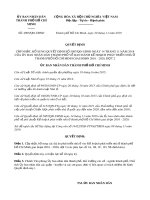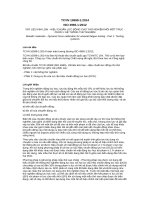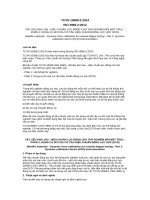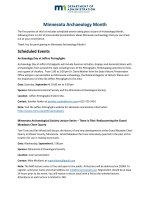- Trang chủ >>
- Đề thi >>
- Đề thi lớp 1
4965
Bạn đang xem bản rút gọn của tài liệu. Xem và tải ngay bản đầy đủ của tài liệu tại đây (80.17 KB, 3 trang )
putting: “the notion itself is less important than the constellation of
concepts it makes possible” (p. 126).
Overall, Pennycook has made a compelling case to question, then
broaden, the range of phenomena often taken for granted in linguistic, cognitive linguistic, and applied linguistic research. The level of
argumentation precludes in-depth analysis of empirical data but makes
the book an important exercise in “rethinking relations between
humans, language, objects and space, and . . . considering more carefully what distributed agency, language and cognition may mean” (p.
18). Central to studies of language has been the relation between languages, bodies, minds, and worlds. Pennycook’s book reminds us why
this relation must continually be rethought.
SIMON HARRISON
City University of Hong Kong
Hong Kong
International Students’ Challenges, Strategies and Future Vision: A
Socio-Dynamic Perspective
Anas Hajar. Bristol England: Multilingual Matters, 2019. Pp. xv + 237.
doi: 10.1002/tesq.573
The current monograph contributes to a growing number of publications on study abroad. It reports on the lived experiences of eight
Arab university students undertaking master’s degrees in the United
Kingdom. Using a longitudinal, qualitative approach, Hajar traces the
participants back to their learning of English in their home countries
in chapters 4 and 5 and up to their experiences in the United Kingdom during a pre-sessional course in chapter 6, their master’s courses
in chapter 7, and their dissertation writing in chapter 8. Through a
socio-dynamic lens, Hajar explores the challenges the students faced,
their strategies for coping with these challenges, and how the students’ future visions helped to motivate them throughout each leg of
their journeys.
In chapter 1, Hajar makes quick work of an introduction, which
includes an autobiographical narrative of his own journey studying in
Syria before embarking on his postgraduate studies in the United
Kingdom. This narrative is brief but important in that it situates
Hajar’s rationale for the current study in his own experiences as a
533
REVIEW
language learner and former Arab sojourner himself; it makes readers
aware of the origin of his interest in language learning strategies.
Although positioned inconspicuously in the middle of the book’s title,
it is evident early on that strategic behavior is Hajar’s main area of
interest.
Chapter 2 provides an up-to-date overview of the literature on language learning strategies that holds its own among similar chapters in
other popular volumes. Readers familiar with existing overviews will
find similar themes here. It is in chapter 3, however, that Hajar’s theoretical contribution comes to life. After moving through more familiar
ground regarding strategies, Hajar begins to weave together aspects
from several theoretical frameworks (from activity theory and communities of practice to investment and possible selves) to form his own
socio-dynamic framework for understanding the relationships between
motivation(s), strategy use, and learners’ future visions. Noteworthy is
Hajar’s categorization of strategies as “compulsory/other-imposed” or
“voluntary” (p. 56). Refraining from lengthy classification systems of
old enables Hajar to conceptualize strategies based on their locus of
causality. Such a distinction mitigates some concerns I have voiced previously regarding conceptualizations of strategic behavior that have
increasingly become conflated with aspects of self-directedness (e.g.,
Thomas & Rose, 2019; Thomas, Rose, & Pojanapunya, 2019). Hajar
uses his compulsory versus voluntary distinction to describe strategy
use amongst his participants in the subsequent chapters.
Chapters 4–8 follow a formula, with Hajar providing background
information and a brief review of literature to foreground each chapter’s focus; then, drawing on more than 15 hours of interviews with
each participant, Hajar introduces 15 to 30 interview excerpts in each
chapter. The excerpts are part of a larger chapter narrative that
focuses on a specific period in the learners’ journeys (see above), presented in chronological order. Hajar’s analyses and discussions are
sensible and grounded in existing work. Finally, each chapter concludes with implications, mostly pedagogical.
On the whole, I found this monograph thought-provoking. While
Hajar states early on that this volume is “a new exploration of language learning strategies” (p. 1), it is obvious that it explores far more.
Strategies are simply the point of departure for much larger discussions of transition, motivation, and identity. Essentially, it is Hajar’s indepth approach to understanding his participants’ experiences that
makes this memorable. It clearly draws influence from Gao’s (2010)
earlier work, and both are excellent examples of the type of qualitative
inquiry that the strategy field has, for the most part, been lacking.
I have just a couple of minor critiques. First, the book would have
benefitted from a final chapter to tie everything together. I turned the
TESOL QUARTERLY
534
last page of chapter 8, expecting to see a larger synthesis of the key
topics, only to find an invited epilogue. It would have been nice to
read Hajar’s own concluding discussion on the book’s larger themes.
Second, some of the chapter/section titles could have been a bit more
representative of their respective content (e.g., chapter 2, part 2, and
part 3). Nevertheless, I thoroughly enjoyed reading this volume and
recommend it to anyone interested in learning strategies, study
abroad, and/or transition.
THE AUTHOR
Nathan Thomas is a postgraduate researcher at the UCL Institute of Education.
His interests are wide-ranging, but current projects pertain to language learning
strategies, self-/other-regulation, and English medium instruction. He has published in leading academic journals such as Applied Linguistics, Applied Linguistics
Review, ELT Journal, Language Teaching, System, and TESOL Quarterly.
REFERENCES
Gao, X. (2010). Strategic language learning: The roles of agency and context. Bristol,
England: Multilingual Matters.
Thomas, N., & Rose, H. (2019). Do language learning strategies need to be self-directed? Disentangling strategies from self-regulated learning. TESOL Quarterly,
53, 248–257. />Thomas, N., Rose, H., & Pojanapunya, P. (2019). Conceptual issues in strategy
research: Examining the roles of teachers and students in formal education settings. Applied Linguistics Review: Advance online publication. />1515/applirev-2019-0033
NATHAN THOMAS
University College London,
Institute of Education,
London, England
535
REVIEW







